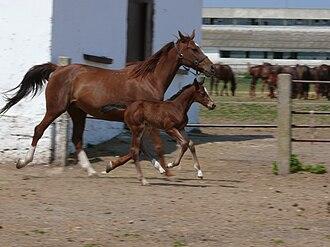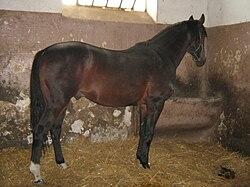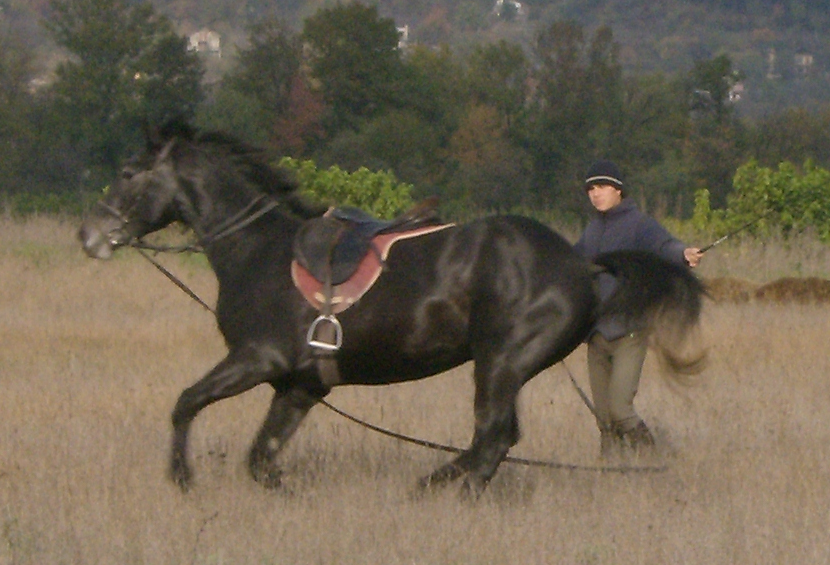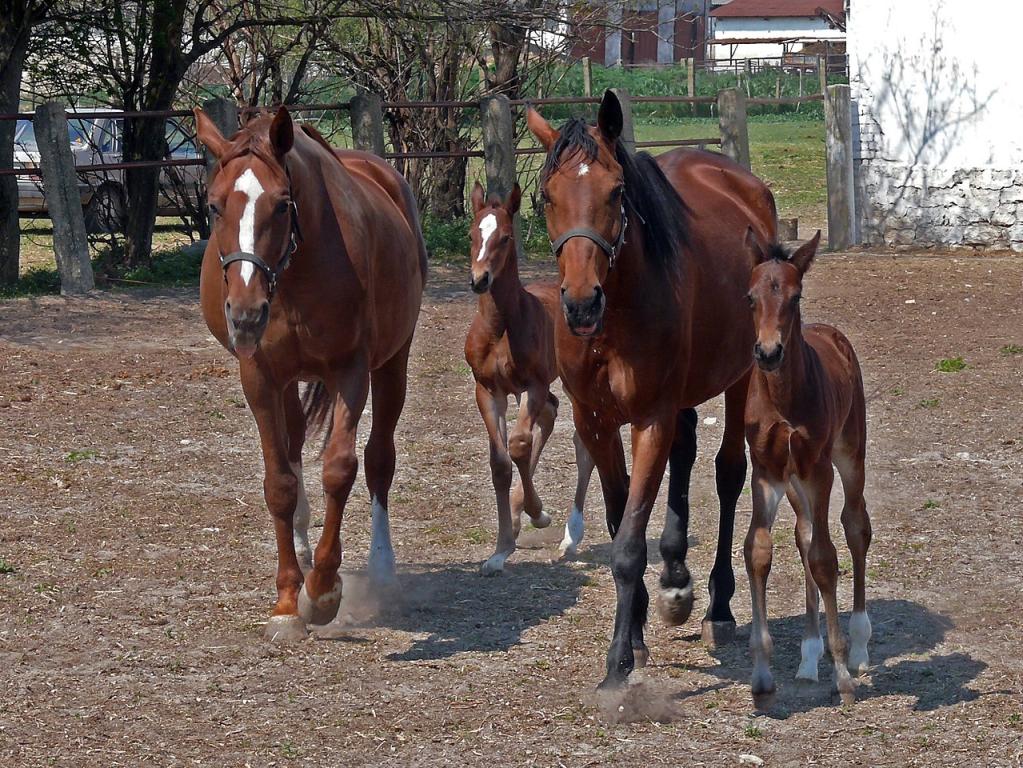
Continent:
Country: Bulgaria
Weight: 450 – 550 kg
Height: 150 – 160 cm



The East Bulgarian horse originates from the national stud farms of Kabiuk (near Shumen) and Bozhurishte, where it was developed in the late 19th century.
This breed was created through controlled crossbreeding of local mares, Arabians, Anglo-Arabs, and English half-breds with imported Thoroughbred stallions, without direct contribution from native Bulgarian horses.
Officially recognized in 1951, the breed was designed to meet the military, then sporting needs of Bulgaria.
It reflects a national effort to align with European sport horse standards while remaining adapted to local breeding and training conditions.
The East Bulgarian horse is traditionally bred in eastern Bulgaria, particularly around the national stud farms of Kabiuk (near Shumen) and Bozhurishte (near Sofia).
The Kabiuk stud remains the main center for the breed’s conservation and reproduction, housing a large share of the remaining population.
While present across Bulgaria, the breed is concentrated in the east, where breeding infrastructure and equestrian traditions are more developed. Founding mare families are still maintained there under strict stud-book monitoring.
In 2009, the breed became eligible for EU subsidies aimed at conserving endangered animal breeds, which has helped sustain small private breeders in rural areas.
The East Bulgarian horse plays a significant role in Bulgaria's equine selection history, as a synthetic sport breed created through structured crossbreeding with high-value genetic stock (Thoroughbreds, Anglo-Arabs, Hanoverians, Trakehners...).
Its genetic value lies mainly in:
- The breed's model homogeneity, achieved through generations of rigorous selection, notably thanks to strong Thoroughbred influence.
- The improvement of lightness, elegance, and fluidity in Bulgarian sport horse lines.
- The conservation of certain founding sire lines now rare in Eastern Europe (e.g., Laudon, Kozak, Worcestershire, Tihany, Edelknabe).
- Its adaptation to various sport disciplines, making it a potential genetic contributor in crosses aimed at improving endurance, strength, and jumping ability.
Despite its currently low population, the breed remains genetically valuable for preserving historic bloodlines and offering a sport horse base independent from Western stud-books.
The East Bulgarian is a sport horse developed in Bulgaria at the end of the 19th century, in a context of modernizing national horse breeding.
Unlike other national breeds, it does not descend from native stock but was created through controlled crosses between local, Arabian, Anglo-Arab, and English half-bred mares, and imported Thoroughbred stallions.
Initial breeding took place at the state studs of Kabiuk (near Shumen) and Bozhurishte (also known as "Stefan Karadja"). The selection plan aimed to produce a light saddle horse suited for military and later sport purposes.
The breed was officially recognized in 1951 by ministerial decree. Its stud-book was opened in 1959, structured by paternal lines and maternal families. Key founding sires include Laudon, Kozak, Gremy, Worcestershire, Edelknabe, Tihany, and Zenger.
From the 1980s onward, selection focused decisively on the sport horse type, with controlled introduction of Hanoverian, Trakehner, Holsteiner, and Selle Français bloodlines to improve performance in dressage, show jumping, and eventing.
By 1987, the East Bulgarian represented nearly 40% of the registered purebred horses in Bulgaria.
Since the 2000s, the breed has experienced a sharp decline in numbers and is considered endangered. A conservation program supported by European subsidies and a complete stud-book revision has been implemented.
The Kabiuk stud farm remains central to preserving this uniquely Bulgarian breed.
The East Bulgarian horse is known for its balanced temperament and willingness to work. Initially selected for light draft and later sport, it combines energy, suppleness, and responsiveness without excessive nervousness.
Well-trained individuals generally show strong cooperation with riders, making the breed appreciated in competition, leisure riding, and teaching. It is also reputed for its endurance, quick recovery, and ease of care, even in intensive or semi-intensive breeding systems.
Its natural liveliness makes it dynamic and capable while remaining manageable for intermediate riders. Some horses may display a more frank and expressive character inherited from Thoroughbred ancestors, requiring trust and consistent training.
The East Bulgarian horse is currently listed as a critically endangered breed, with only 150 to 200 registered breeding animals.
Despite this demographic fragility, several factors suggest promising prospects:
- Revaluation as a national breed: the East Bulgarian is seen as a genetic and cultural heritage of Bulgaria, motivating conservation efforts.
- Institutional support: since 2010, EU conservation subsidies are allocated to breeders, encouraging purebred reproduction.
- Return to versatility: its good temperament, sturdiness, and sport potential (especially in eventing and show jumping) generate renewed interest from riders seeking a functional, rustic, and athletic horse outside mainstream circuits.
- Sport-oriented crossing: the breed continues to be improved through moderate infusion of Hanoverian, Trakehner, and Holsteiner blood, while preserving its own identity.
However, limited genetic diversity and competition from international sport breeds remain serious challenges. The breed's survival will depend on the active collaboration of breeders, institutions, and enthusiasts to ensure both purebred continuity and international visibility.
The East Bulgarian horse is generally robust and hardy with good functional longevity. It has a solid build, dry limbs, and hard hooves, granting excellent aptitude for work, especially outdoors and on rough terrain.
Veterinary data indicate no known specific hereditary diseases.
However, a 2004 study showed lysozyme concentrations (immune response indicators) comparable to Thoroughbreds but lower than in more rustic breeds like Hanoverians, suggesting moderate sensitivity to infections, especially under intensive breeding conditions.
A 2006 study noted a potential risk of intoxication from Datura stramonium (a toxic plant) if grazing is uncontrolled. This risk is not breed-specific but linked to management practices.
Overall, the East Bulgarian is a healthy, rustic, and enduring horse when raised with appropriate physical activity and nutrition.
Born on 01/01/1965
East Bulgarian mare who represented Bulgaria at the 1972 Munich Olympic Games in eventing. She is one of the few representatives of the breed to have competed at such an international level, making her a symbol of performance for the stud-book.